SELECTION OF QUESTIONS AND ANSWERS
AUGUST 1999 PART 1
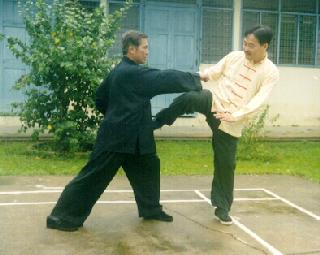
|
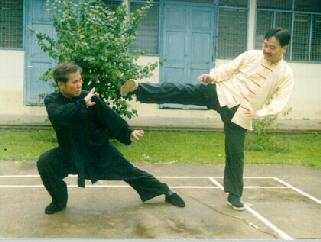
|
Sifu Wong attacks with "Black Tiger Steals Heart". Instead of blocking, Goh leans back and simultaneously responds with a side kick, known in Shaolin Kungfu as "Yellow Bird Hops up Branch". Sifu Wong uses "Taming Tiger with Beads" to avoid the kick. These forms are used because they give certain technical advantages over haphazard movements made at the spur of the moment.
Question 1
Dear Wong Sifu, I would like to know how would Tai Chi Chuan fair against other martial arts in combat. I am aware about some of the wonderful benefits practising Tai Chi Chuan can bring to your life, like heightened awareness, grace, improved health, activeness even in old age, self-defence without the compromise of deterioration of the body, character development, and even spiritual discoveries in advanced stages. However, with all other multitudinous plus points aside, how useful is Tai Chi Chuan in combat against other martial arts?
— Hui, Singapore
Answer
Tai Chi Chuan is basically a martial art. All the benefits you have mentioned about Tai Chi Chuan are true, yet they are only secondary benefits which Tai Chi Chuan exponents get as a bonus; the primary benefit of Tai Chi Chuan is combat efficiency which is a logical result of the primary aim of Tai Chi Chuan as a martial art.
In other words, in the past people practised Tai Chi Chuan not because they wanted to have hightened awareness, grace, improved health, etc, but because they wanted to fight well. Heightened awareness, grace, improved health, etc came about as a bonus of practising Tai Chi Chuan for combat. Even the bonus is so wonderful; this will give an idea how more wonderful is the main result, i.e. its effectiveness for combat.
Theoreticaly speaking, consideing combative factors like force, techniques and strategies, Tai Chi Chuan is far superior in combat than many martial arts or martial sports like Judo, Aikido, Karate, Taekwondo, Western Boxing and even Siamese Boxing.
One crucial point that many people often do not realize is that these other arts are sports, governed by safety rules, whereas Tai Chi Chuan is not limited by any rules. In a real fight in the past if these martial artists were to use their typical techniques to attack a Tai Chi Chuan master, they would be killed or seriously injured.
For example, if a Judo exponent were to hold a Tai Chi Chuan master to prepare for a throw, the master could kill the Judo exponent with a devastating palm strike on the head. If a Taekwondo exponent were to use high kicks to attack the Tai Chi Chuan master, the master could smash the opponent's sexual organs.
Such a situation does not happen today because of two reasons. One, ours is a law-abiding society; real fights in the past where killing or maiming was common, are happily obsolete. Two, very, very few people today practise Tai Chi Chuan; most people perform Tai Chi dance, and of course Tai Chi dance is no match for these martial arts or sports.
Question 2
My acquaintance told me that all kungfu (as well as Tai Chi Chuan) is useless against modern combative arts like Brazillian Jujutsu, Vale Tudo, especially Muai Thai. I also received a URL from him on his page that supposedly showed that all kung fu inferior to these "formless" martial arts (this term was popularised after Bruce Lee said that kungfu emphasized too much on "classical forms" and "dead techniques", and that his fighting was formless).
Answer
Your acquaintance did not have a chance to know real kungfu, including Tai Chi Chuan. This is in fact the norm. Very, very few people have the chance to experience real kungfu; most people practise or witness kungfu gymnastics or dance. How many kungfu students you know, for example, spend time on force training and methodical sparring, which are crucial aspects of real kungfu? Most of them spend most of, if not all, their time on form practice, which is in many ways the least important aspect of kungfu. Those who have spent all their lives demonstrating forms to please spectators, and have never learnt to spar at all, will be no match against any fighter.
The forms in kungfu are the crystalization of centuries of real fighting techniques. In the beginning people fought without forms. Then they discovered that by adopting certain positions and using certain movements in given combat situations, they would have certain advantages.
For example, instead of punching in a haphazard manner with their feet apart, they found that they would have more power as well as stability if they placed one leg in front of the other and punched from their waist, spiraling the fist in the punching momentum. This gradually developed into the technique of thrusting a punch at the bow-arrow stance. This technique, executed in this way, constitues a kungfu pattern, and is named in Shaolin Kungfu as "Black Tiger Steals Heart".
When a fighter using the "Black Tiger Steal Heart" pattern was counter-attacked by an opponent using a side kick, he could respond in numerous ways. Masters discovered that one good way was merely shifting the body backward, without moving the feet, as this would give the exponent speed as well as conservation of energy. This developed into the pattern called "Taming a Tiger with a String of Beads".
Later the masters discovered that instead of merely avoiding the kick, the exponent could strike the kicking leg, thus gaining the advantage of striking an opponent at a time when his initial attack is just spent. This developed into the pattern "Lohan Strikes Drum".
These two patterns underwent further development in Tai Chi Chuan. In line with "softness" in Tai Chi Chuan, the Shaolin "Black Tiger" pattern evolved into the softer Tai Chi pattern called "Punch Below Sleeves", where energy flow instead of speed and momentum is emphasized. Instead of striking the opponent's leg using the comparatively forceful "Lohan Strikes Drum", a Tai Chi Chuan exponent would use the softer "lu" technique of "Grasping Sparrow's Tail" to grip and dislocate the opponent's angle.These kungfu techniques, manifested in kungfu patterns, were not invented by someone sitting in an ivory tower, but were evolved through actual fighting over many centuries. To untrained persons, these techniques would be cumbersome; it would be easier and more "natural" for them to throw a punch in an ordinarily standing position or to jump away when kicked at, than to use the Black Tiger or the Lohan patterns.
It needs much time to practise these patterns until they become second nature, and it needs even more time to practise using them effectively in combat. Most kungfu students lack the method or the patience for such practice. As a result, even though they may perform these patterns beautifully in solo demonstrations, they are unable to use them at all in combat.
Despite what Bruce Lee said, he used forms in his fighting. He did not kick haphazardly, he adopted certain positions and kicked in certain ways so as to have definite combative advantages, particularly power and speed. His forms, nevertheless, resemble more of Taekwondo than of traditional kungfu.
What Bruse Lee meant was one should not be slavishly tied to his forms. More significantly he emphasized that kungfu forms were for fighting, not for beautiful demonstrations. He was remembered for echoing the kungfu tenet, "kungfu progresses from formless to form, then completing the full circle from form to formless". In other words, before one learns kungfu, he fights haphazardly. Then he learns kungfu forms, which give him the most advantageous techniques for fighting. Having mastered the forms, he may modify them to suit the particular combat situations.
There is no doubt that Bruce Lee was a great fighter, and he contributed much to the popularity of kungfu. But, paradoxically, I think his understanding of traditional kungfu was not deep. I must clarify that I am merely stating my opinion, and I mean no disrespect to this great fighter.
Had his understanding of kungfu deep, he would have used traditional kungfu techniques in combat instead of those of Taekwondo; he would have used traditional kungfu force training involving mind and energy instead of using western mechanical means; and most crucially he would have realized the importance of gradual progress and not have overtrained and abused himself. Yet, having said all these, we salute this man who gave his life to martial arts.
Question 3
The site had examples of kungfu, Tai Chi Chuan, and san shou exponents losing to Muai Thai exponents. In fact, according to him, history has proved so far (in the fights) that kungfu cannot handle the moves in other "formless" martial arts. According to my aquaintance, nobody ever attacked Tai Chi experts of the past like Yang Lu Chan with low roundhouse kicks to the thighs "that will make one unable to even stand" or "grab his neck/head and throw continuous knees into his ribs." Hence, he concludes that Tai Chi experts are no match to "formless" fighting, and is an obselete art for combat.
Answer
Your acquaintance based his conclusion from the shameful performance of kungfu gynmasts and Tai Chi dancers, most of whom have never sparred in their lives, and his knowledge of kungfu history is grossly limited. Obviously he did not know that in the late 19th and early 20th centuries, many martial art masters from many foreign countries went to China to test the Chinese masters, and virtually all of them were defeated.
For those used to thinking Tai Chi dance is Tai Chi Chuan, it is difficult to imagine how extremely powerful and combat efficient Tai Chi Chuan masters like Yang Lu Chan were. Yang Lu Chan went round China to test his own skills, meeting masters of various styles, and he was never defeated, earning the nickname "Yang the Ever Victorious". Some masters would have used the low roundhouse kicks, known in kungfu as "whirlwind kicks", on him, and he could easily counter with an appropriate modification of his favourite Tai Chi pattern "Grasping Sparrow's Tail", throwing the attackers to the ground.
No one would be so foolish as to try grabbing his neck or head, or throwing continuous knees into his ribs, for that would be asking for trouble. With the opponent in such unguarded close quarters, all Yang Lu Chan had to do was to strike his powerful Tai Chi palm into the opponent's chest, killing or seriously injuring him. Please refer to What could a Taijiquan master like Yang Lu Chan do if a Muai Thai fighter grabs his neck or head and throws continuous knees into his ribs? for some details on Taijiquan techniques against Muai Thai knee jabs.
My hometown, Sungai Petani, is near Thailand, the home of Muai Thai. Some of my students were Muai Thai fighters and instructors before they learned Shaolin Kungfu from me. My Shaolin students could handle ferocious Muai Thai techniques from these fighters quite comfortably. I owed this to my master, Sifu Ho Fatt Nam, who was a professional, not just an amateur, Muai Thai fighter and champion before he gave it up for Shaolin Kungfu. My students and I are no where when compared with Yang Lu Chan; this is not modesty, I am being honest.
Remember also that happily in our modern days, sparring -- even amongst professionals -- is taken as a sport. But in the past in China, combat was often a serious life-death matter. Combatants fully knew that a slight mistake or a poor defence might cost them their lives. They simply had to be good fighters to survive. This will give an idea of the difference in standard between real combat in the past and sparring today, even with ferocious Muai Thai fighters.
You may explain to your acquaintance to help him widen his perspective, but if he insists that formless martial art or Muai Thai is superior, there is no necessity to argue with him. His narrow-mindedness constitutes his loss, not yours. If we are convinced that Shaolin Kungfu or Tai Chi Chuan is a great martial art, we practise diligently to derive the benefits, and perhaps share it with those who sincerely seek our help. But we have no need to prove to others, or to waste time arguing with those who stubbornly close their mind.
Question 4
What troubles me is that what I trust to be a great, advanced art that is perfected over the ages can actually be beaten by someone who spends (significantly) less time on a newly created martial art. Aren't Shaolin Kungfu and Tai Chi Chuan widely known to be the best fighting arts in the world? Can you enlighten me on this?
Answer
Shaolin Kungfu and Tai Chi Chuan are the greatest martial arts in the world, and their greatness lies beyond fighting. When I was still a boy I read a master saying that comparing other martial arts with Chinese martial arts is like comparing a drop of water with an ocean. At that time I thought he was chauvinistic and exeggerating beyond reasons. But now, having experienced the scope and depth of Shaolin Kungfu and Tai Chi Chuan, I am beginning to see the truth in his comparation.
You are disappointed because you, like most people, have mistaken external demonstrative forms, known as "flowery fists and embrodery kicks" in idiomatic Chinese, for real kungfu. The fact is that real kungfu, whether Shaolin or Tai Chi Chuan, is very, very rare; what we normally see is external demonstrative forms. Because of its scope and depth, it is understandable that we need much more time to be proficient in real kungfu, but once we are properly and sufficiently trained, defencing ourselves against opponents of other martial arts would not be a problem.
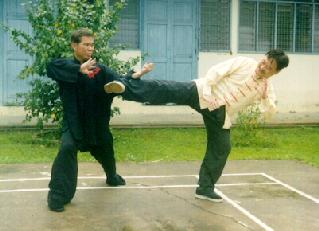
Instead of avoiding the kick by using "Taming Tiger with Beads" as in the picture above, a better response which is a technical development from the "Beads" form is "Lohan Strikes Drum" as shown here. If you practise this "Lohan" form well, and be able to apply it spontaneously whenever an opponent attacks you with a side-kick, instead of thinking what responses to use or making haphazard movemnts, you will also have a tactical advantage over your opponent. These are some of the advantages of using form in combat over formless fighting.
Question 5
At the same time, it also puzzles me. The ultimate combat goal of all "internal" martial arts especially is to become formless. How is it that such famous kungfu experts are still fighting in forms? Or is real Kung Fu and Tai Chi Chuan really inferior to these new arts?
Answer
The expression that at an advanced stage Chinese martial artists (not just the internal ones) become formless in combat, means that the decisive factor in combat has shifted from techniques (which have form) to force (which is formless). If you have so much internal force, it does not matter what forms or techniques you use, just one strike on your opponent is enough to finish him off.
This will also give you an idea of the different standard between Chinese martial arts and the other arts. A Karate punch or a Taekwondo kick may be destructive when connected on an untrained person, but to a Chinese master with Golden Bell, Iron Shirt or other forms of internal force, the punch or kick actually does not worry him much. But just one strike of his Iron Palm, Cosmos Palm or an attack packed by tremendous internal force may kill or maim. This is one reason why freely kicking and punching each other in sparring which is normal in many other martial arts, is untinkable in kungfu.
In another dimension, formlessness refers to mind, in contrast to physical body. Have you heard of this expression, which is not commonly mentioned: "In advanced kungfu you fight with your heart"? Here "heart" means mind, and is formless.
At the highest level, formlessness refers to the greatest spiritual achievement. In Shaolin Kungfu it is attaining Zen or enlightenment; in Tai Chi Chuan it is attaining Tao or returning to the Great Void.
Question 6
How would Tai Chi Chuan fair against Chinese martial arts with confusing and strange footwork like Baguazhang and Drunken Fist, or Monkey Kungfu? Tai Chi Chuan, like Chang Chuan, seems very direct and straight forward. Would this not be a disadvantage against such styles with confusing and unpredictable footwork?
— Stephanie, USA
Answer
In terms of combat efficiency, Tai Chi Chuan, Baguazhang, Drunken Fist and Monkey Kungfu belong to the same very high level of kungfu. In terms of mind expansion and spiritual cultivation, Tai Chi Chuan is the highest, Baguazhang next, whereas Drunken Fist and Monkey Kungfu are basically meant for fighting.
Because of historical development, different needs and other reasons, they have different emphasis in their approach to combat. Tai Chi Chuan makes much use of circular movements and energy flow, whereas the other three emphasize on agile footwork. While Tai Chi Chuan and Baguazhang are comparatively more straight-forward, Drunken Fist and Monkey Kungfu make use of deceptinve moves. All these four styles use internal force.
If all other things are equal, then these styles with confusing and unpredictable footwork would be an advantage over Tai Chi Chuan. But other things are not equal. Although in comparation a Tai Chi Chuan exponent generally remains at his stance, his circular movements make him very versatile. So instead of moving his feet in agile footwork to avoid an attack, he merely swerves his body to deflect the attacking force, then turning it back to the opponent, thus securing an advantage instead of a disadvantage. Thus whether a Tai Chi Chuan exponent is a better fighter than one practisng Baguazhang, Drunken Fist or Monkey Kungfu will depned on numerous formless variables like force, skill and temperament, besides the form variables of techniques.
Question 7
I read in a Baguazhang book that Xing Yi is good for close range, Tai Chi Chuan is good for middle and close ranges, while Baguazhang is good for all ranges. Does this mean that Baguazhang is superior to Tai Chi Chuan, since it can handle attacks of all ranges, or is this an insignificant piece of information when it comes to actual self-defence?
Answer
I disagree with the opinion mentioned in that book. To me, all these three arts are good for all ranges. If Baguazhang or Xing Yi Kungfu were superior to Tai Chi Chuan, then more people would practise these two arts.
But in fact the number of Tai Chi Chuan exponents far outnumber that of Baguazhang or Xing Yi Kungfu. While the number of exponents itself is not a definite indication of the superiority of an art as other factors are also involved, it does has some relationship.Question 8
No matter what your answer is, I will still practise my Tai Chi Chuan with deligence and hardwork to bring myself to a good level of combat efficiency and where I will fully benefit from the art, because Tai Chi Chuan is a great part of my culture.
Answer
While you attitude reveals that you are proud of your cultural roots, it may not necessarily be a wise one. If, for example, my answer were very unfavourable to Tai Chi Chuan -- which of course it isn't -- you should seek a second, and then a third opinion.
If all expert opinions expressed that Tai Chi Chuan were an inferior art, you should have the courage to accept the inferiority of your roots and change to a better art, or if you have the capabilities, improve it. But as it is, Tai Chi Chuan is a wonderful art. What is important is that you should differentiate between Tai Chi dance and Tai Chi Chuan.If you continue practising Tai Chi dance you will further the degradation of a wonderful art, bring shame and ridicule to it like what Taiji dancers had done. But practising real Tai Chi Chuan is not easy -- it is very difficult to find a genuine Tai Chi Chuan master, and even if you have found one, it is very demanding to practise it. The rewards, however, are worth the time and effort.
Question 9
Hi. Do you offer any videos of exercises for a person seeking to improve his/her health? I am 53 years old, female, with a history of slightly elevated blood pressure and cancer. Am looking for an exercise program that (1) calms me down, (2) promotes peace and harmony inside (and outside), and (3) improves my health, especially related to health problems I have had in the past. I am not really available for classes but would be very interested in acquiring a video of these exercises. Please e-mail me back with your response. Thank you.
— Caren, USA
Answer
One thing that keeps amazing me is the number of people with serious health problems, including those suffering from cancer and high blood pressure, who do not bother to take some trouble learning an art that can give them good health but expect to overcome their health problems by learning from an e-mail or a video! Despite having spent much time lying in hospitals, they consider spending the time and effort to learn an invaluable art too troublesome.
Just consider this: if modern doctors with their sophisticated technology could not overcome the so-called incurable diseases, could e-mails and videos do? One would also consider whether practising chi kung could overcome the so-called incurable diseases. The answer for the first question is obviously no, and for the second question yes. In my own experience, as a rough estimate about 80% of my students with so-called incurable diseases have successfully overcome them. But I do not keep records, and so if you ask me for names I cannot provide for you; you either believe me or you don't.
One main reason why so many people have such mistaken information about chi kung and believe that chi kung can be effectively learnt from a video is that chi kung has be so diluted today that it has virtually lost its essence, and many people have commercialized on chi kung videos. You can readily learn external chi kung forms from a video, but that is not real chi kung -- it is only its external forms. Fundamentally, real chi kung concerns training mind to manage energy, and this has to be learnt from a master or at least a competent instructor who himself has the ability of mind managing energy, certainly not from a video which may teach you chi kung dance forms or from a bogus instructor who himself has no experience of energy flow.
Real chi kung can calm you down, promote peace and harmony inside and outside, improve your health, and much, much more, but you have to take some effort and time to learn it from a master. And when you have the chance to learn from a master, you do not call him "hi", which you normally address to your peers; you call him "master" or in Chinese "sifu", which signifies proper respect for someone kind enough to share his treasure with you.
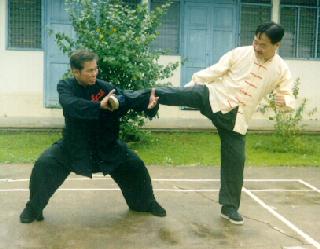
|
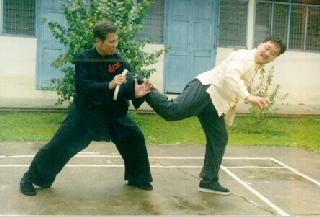
|
Sifu Wong applies the "lu" technique in the Taijiquan pattern "Grasping Sparrow's Tail" to trap Goh's side kick. As Goh tries to pull back his leg, Sifu Wong follows through with the "li" technique to dislocate Goh's angle.
Question 10
Sifu, I purchased your book "Chi Kung for Health & Vitality" but I realize I need a qualified teacher to start me off correctly. Currently, I have diabetes, high blood pressure and suffer from impotence and being overweight. My medication just seems to make matters worse. I realize that only my symptoms are being treated and not the causes.
I am anxious to get started and reverse these so called incurable diseases. Is there a student of yours located near my place that may be interested in working with me until I can take a course with you? I realize you don't want to invade their privacy by giving me their address or phone number but would you consider passing on my phone number and email address to them and if they were willing they could contact me? Thank you so much for your time and trouble.
— Ken, USA
Answer
Chi kung can overcome the health problems you have, i.e. diabetes, high blood pressure, impotency and overweight, and much more, including giving you vitality, mental freshness and spiritual joy. I do not have any students in the U.S. qualified enough to teach chi kung the way I want it to be taught.
In fact I asked some of my senior disciples in Malaysia to teach chi kung; after trying for some time they gave up because although they could teach much better than many chi kung teachers on the open market, they found that they could not do a portion of what I am doing. They could not, for example, get their students to experience energy flow in their very first lesson, or open their energy points as effectively as I do to speed up the students' progress. Hence, in line with the Shaolin teaching that we cherish, they believe that I should do the teaching.
Question 11
I was interested to read some of the comments from your chi kung students and some of the problems/phenomena they'd encountered. Having been going through chi kung training for the last four months, I have not yet experienced anything like what they describe (and their descriptions were not overly revealing). Can you offer some insight?
— Pam, USA
Answer
There are three possibilities why you have not experienced those chi kung effects that some of my students have described.
1. You have not practised long enough. In most types of chi kung, people have to practise for about a year before they can experience some interesting chi kung effects. However, in high level chi kung, the effects may be felt within a short time. Most of the students taking my intensive chi kung courses feel the effects immediately; this is one of the reasons they are satisfied with the courses and pay the comparatively high fees.
2. You may have practised incorrectly, in which case you may not have the effects.
3. What you have practised is only external chi kung form. As you have missed the essence, you may not have the effects no matter how long you have practised.
Question 12
I know that there used to be 5 shaolin temples in China, please correct me if I'm wrong, but some of them were destroyed. Which ones are left?
— Thanx, Taiwan.
Answer
There were really two Shaolin Temples, one in Henan province and the other in Fujian. Both were destroyed, but the northern temple in Henan has been restored by the Chinese government in Beijing. The government has found the site of the southern temple and is contemplating to restore it too.
There were other temples which followed the tradition of Shaolin. Two notable examples were the Long Tan Temple (or Dragon's Pool Temple) in Shangtung province, from where Tan Tui Kungfu developed (famous in Chinese circles, but not well known among non-Chinese), and Xi Chan Temple (or Western Zen Temple) in Guangdong, which played a crucial role in the development of many southern Shaolin styles.
Question 13
How can one be accepted in the Shaolin Temple?
— Janowskis, New Zealand
Answer
In the past it was a rare privilege and honour to train in any one of the two Shaolin Temples. An aspirant had to kneel for three days outside the temple gate before he could be considered to be accepted as a monk. Only those monks who were promising were chosen to practise Shaolin Kungfu, and they spent the first few years doing odd jobs which were actually a means to test their patience as well as develop their internal force.
Today I do not think anyone is accepted into the northern Shaolin Temple for martial art training. With thousands of daily visitors, there is simply no time or place for serious kungfu training inside the temple grounds.
Nowadays those who say they have practised kungfu in the Shaolin Temple actually mean they have learnt wushu, which is a modern form of demonstrative kungfu without its combat and spiritual aspects, in one of numerous wushu schools located around the northern Shaolin Temple. The standard of wushu taught here is very high, and is often conducted by monks seconded from the Shaolin Temple. If you wish to study in one of these wushu schools, you have to contact them.
